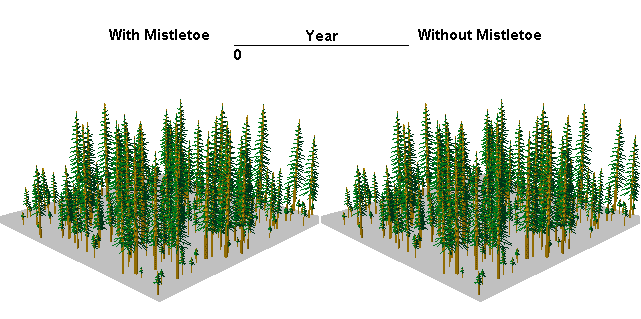FVS Models & Event Monitor Files
The Forest Vegetation Simulator (FVS) is a family of models used for predicting forest stand dynamics (tree growth, mortality, regeneration, management, disturbance, etc.) throughout the United States. The Forest Health Assessment and Applied Sciences Team supports a variety of insect and pathogen models that allow FVS users to incorporate forest pest disturbances into their FVS projections.
The family of FVS models comprises 20 different geographic variants, each calibrated to local conditions. Insect and disease models for FVS are developed and maintained in partnership with Forest Health Protection and the Forest Management Service Center . The models take one of two forms: (1) FVS model extensions, which are integrated into and interact directly with the base FVS model, or (2) keyword component (kcp) files, which contain FVS keywords instructing the base FVS model to perform specific calculations and activities (such as mortality) during a simulation. Availability of insect and disease models varies by FVS variant, as summarized below. Pest-specific information on extensions and event monitor files are available in the sidebar.

Image represents a stand of Douglas-fir in the Fremont National Forest as simulated with the South Central Oregon Northeastern California variant of the Forest Vegetation Simulator (FVS) and the Dwarf Mistletoe Model. View animation (Opens in new window/tab)
![]()
| Extenstions or Event Monitor Files | |||||||||
|---|---|---|---|---|---|---|---|---|---|
| FVS VARIANT | DM | DFB | DFTM | LPMPB | WPBR | WRD | WSB damage |
WSB defoliation |
|
| AK | |||||||||
| BM | |||||||||
| CA | |||||||||
| CI | |||||||||
| CR | |||||||||
| CS | |||||||||
| EC | |||||||||
| EM | |||||||||
| IE | |||||||||
| KT | |||||||||
| LS | |||||||||
| NC | |||||||||
| NE | |||||||||
| PN | |||||||||
| SN | |||||||||
| SO | |||||||||
| TT | |||||||||
| UT | |||||||||
| WC | |||||||||
| WS | |||||||||
| Acronym | FVS Geographic Variant | Acronym | FVS Geographic Variant |
|---|---|---|---|
| AK | Southeast Alaska, Coastal BC (SEAPROG) | BM | Blue Mountains |
| CA | Inland CA, Southern Cascades (ICASCA) | CI | Central Idaho |
| CR | Central Rockies | CS | Central States |
| EC | Eastside Cascades | EM | Eastern Montana |
| IE | Northern Idaho - Inland Empire | KT | Kootenai/Kaniksu/Tally Lake (KOOKANTL) |
| LS | Lake States | NC | Northern California (Klamath Mountains) |
| NE | Northeast | PN | Pacific Northwest Coast |
| SN | Southern | SO | South Central OR, Northeast CA (SORNEC) |
| TT | Tetons | UT | Utah |
| WC | Westside Cascades | WS | Westside Sierra Nevada (WESSIN) |
| Acronym | FVS Model | Acronym | FVS Model |
|---|---|---|---|
| DM | Dwarf Mistletoe | DFB | Douglas-fir Beetle |
| DFTM | Douglas-fir Tussock Moth | LPMPB | Lodgepole Mountain Pine Beetle |
| WPBR | White Pine Blister Rust | WRD | Western Root Disease |
| WSB (damage) | General Defoliation Model (previously Western Spruce Budworm) |

